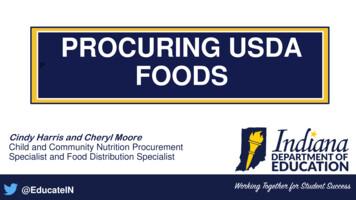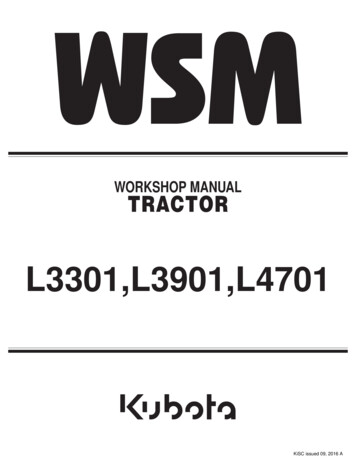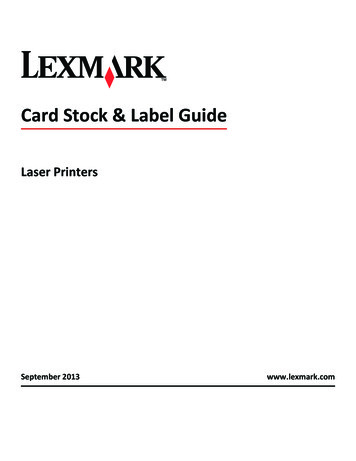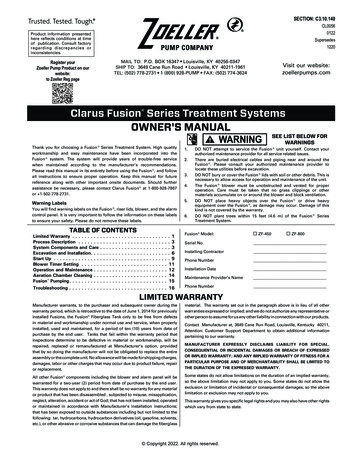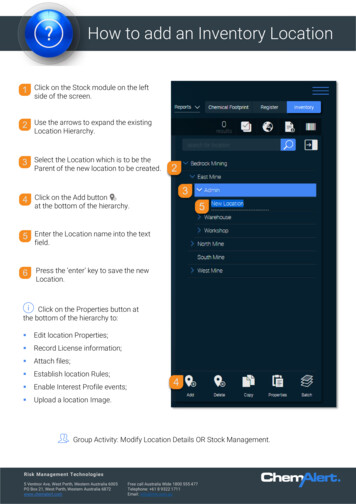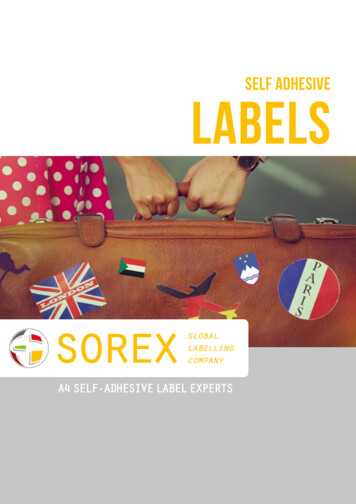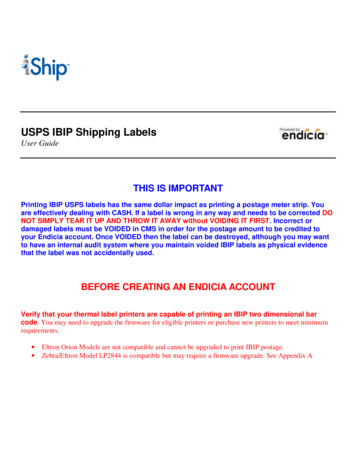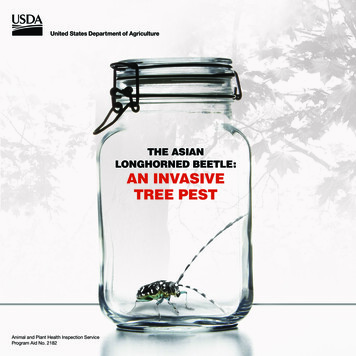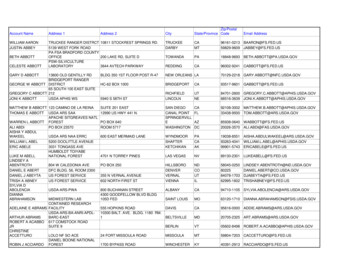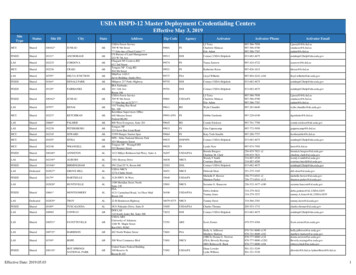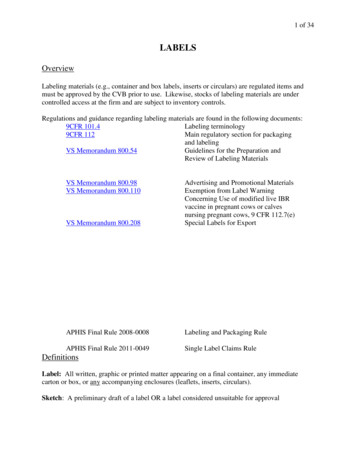
Transcription
1 of 34LABELSOverviewLabeling materials (e.g., container and box labels, inserts or circulars) are regulated items andmust be approved by the CVB prior to use. Likewise, stocks of labeling materials are undercontrolled access at the firm and are subject to inventory controls.Regulations and guidance regarding labeling materials are found in the following documents:9CFR 101.4Labeling terminology9CFR 112Main regulatory section for packagingand labelingVS Memorandum 800.54Guidelines for the Preparation andReview of Labeling MaterialsVS Memorandum 800.98VS Memorandum 800.110VS Memorandum 800.208Advertising and Promotional MaterialsExemption from Label WarningConcerning Use of modified live IBRvaccine in pregnant cows or calvesnursing pregnant cows, 9 CFR 112.7(e)Special Labels for ExportAPHIS Final Rule 2008-0008Labeling and Packaging RuleAPHIS Final Rule 2011-0049Single Label Claims RuleDefinitionsLabel: All written, graphic or printed matter appearing on a final container, any immediatecarton or box, or any accompanying enclosures (leaflets, inserts, circulars).Sketch: A preliminary draft of a label OR a label considered unsuitable for approval
Labels2 of 34Special Label for Export: Label approvable only under the provisions described in VSMemorandum 800.208. Practically speaking, these labels contain variances to USDAregulations regarding claims and use and therefore would not be allowable solely under theflexibility provided in 9CFR 112.2(e).Master Label: Finished carton, container, or enclosure label for the smallest size finalcontainer, which serves as a Master template applicable to other designated size containersSubsidiary: A corporation in which the licensed corporation owns in excess of 50% of thevoting stock.Division: A marketing unit established by the licenseeDistributor: One who sells, trades, or markets products he does not produce or importFlow of Information1. Labeling materials must be submitted via the portal by portal enabled firms, but may besubmitted on paper for non-portal enabled firms. Instructions for processing labels electronicallymay be found under “PEL Guide to Processing Labels Submitted Electronically,”Paper submissions require an accompanying APHIS Form 2015, butportal submissions do not. Two paper copies must be submitted, although some firms maysubmit additional copies for their own use. The Program Assistants (PA)s automatically returnany extra copies of the paper labels to the firm, after retaining 1 copy for the CVB.Labels may be submitted as preliminary sketches or in final format. Note: Colored computergenerated images (label proofs) that are identical to, and to the same scale as, the actual label areacceptable for consideration as final labels.2. After log-in, labeling materials are routed to the LIE. Supporting documents, such as apreviously filed sketch of the label, an Outline of Production, or a foreign regulatoryauthorization, are used to aid in review of the current submission.3. The LIE will do a line-wise comparison of the newly submitted label with applicablesupporting documents. The LIE will also review the label for general style and compliance withthe Outline and 9 CFR 112. Notations may be made on the PEL copy of the paper label or on anelectronic version, in which case the LIE mark-up will be uploaded to the ML. He/She willrecord his/her initials and the date on the bottom left corner of the paper label mounting sheet.4. When the LIE has completed his/her review, the label submission is forwarded to theReviewer. The Reviewer does his/her own technical review (taking into account the notationsmade by the LIE) and scientific evaluation of the label. It is the Reviewer’s role to decide whatis supported by filed data and what may need to be changed. Stepwise instructions forprocessing electronic labels are found in theThe instructionsfor “writing” in the following instructions apply only to paper submissions.
Labels3 of 345. After reviewing, the reviewer determines what type of processing stamp should be applied tothe label. There are 4 CVB label stamps, which have been assigned numbers for easy internalreference: #1 (returned as a sketch; not approved for use), #2 (permanent approval), #3(approved for temporary use), and #4 (special label for export). See Appendix I for examples.5.1 If a final label is acceptable without modification, write “#2” on the mounting sheet toindicate that the #2 stamp should be added. This includes labels that meet all USDAregulations, whether for domestic or export use. See the section of this chapter named“Labels for Export Only” for additional instructions on the proper stamp for labels that meetforeign regulatory requirements but contain variances to USDA regulations.5.2 Labels submitted as preliminary sketches are always returned as sketches, as are anyother labels deemed unsuitable for processing or being returned “unprocessed” at the requestof the firm. Write “#1” on the mounting sheet.5.3 If a final format label requires immediate revision, process it as a sketch (use #1 stamp).At reviewer discretion, certain minor revisions may be deferred for a limited period of time,in which case temporary use may be granted instead.5.4 If a final label is acceptable for temporary use, write #3 on the mounting sheet and ensurethat the reviewer comments specify the expiration date. For consistency, the expiration dateis expressed as the last day of the desired month.5.5 If multiple labels are submitted in the same ML, it is acceptable to return some of thelabels as sketches, and some as approved labels, if necessary. You do not have to sketch allthe labels back to the firm, if only one of the labels requires revision. An explanationregarding the sketches should be provided and returned to the firm.5.6 Labels acceptable for defined transitory periods (e.g., interim true names containing oldand new taxonomy) should be assigned a #3 stamp, even though the expiration date may beyears away. Likewise, assign a #3 stamp to labels that should be updated at the next printing.(Have the firm estimate how long they anticipate the initial printing to last.) If such labelsare assigned #2 stamps, there is no mechanism to flag them for archival at the end of theirallowable use period, nor is there any mechanism to identify these labels for follow-up if theyare not replaced in a timely manner.5.7 Unless other arrangements are made, when a submitted label replaces or supersedes anold one, the old label becomes obsolete and is archived as soon as the new one is approved.Often, however, the firm will request permission to use existing inventories of the replacedlabel. The firm will specify on the mounting sheet the CVB-issued identification numbers ofthe labels being replaced. If submitting paper, the firm will use Block 8D of the APHISForm 2015 to request permission to use the remaining inventories of superseded labels. Ifthis is permissible without modification, do not make a comment. An authorized CVBsignature on the processed submission indicates CVB concurrence with the stated request.The default period to use superseded labels is one year. Expiration dates are standardized to
Labels4 of 34the last day of the 12th month after the date on the processed label (Date returned). Either thenew or superseded labeling may be used before, or on the expiration date. If the request isdenied or is acceptable only with modification, provide an explanation in a reviewercomment. These “extended use” labels remain in our active files until the expiration date,after which they are automatically archived.Firms may designate that a label is “in addition to” a previously filed label. “In addition to”should be reserved for cases where there is no intention to retire the related label. If the firmindicates a submitted label is to be used “in addition to” an existing one (instead of as areplacement), but you suspect that the firm simply wants to use existing inventory, contactthe liaison to confirm and edit the information accordingly.5.8 Labels and sketches should never be returned “unprocessed,” unless they are submittedimproperly (e.g., no APHIS Form 2015). In cases where it may seem intuitively appropriateto return a submission unprocessed, always return the submission as a sketch. This ensuresthat we retain a copy of the submission in our labeling files.6. The reviewer prepares the text that will be appended as reviewer comments to the submission.6.1 Prepare the text as a word processing document. Use the template6.2 Name the document according to the naming convention described in the OfficeProcedures section of this manual (e.g., Est ProdCode YYMMDD LBL).6.3 The document should begin with the standard wording found in Appendix II of thissection of the Reviewer Manual.6.4 If there are no comments, write “NC” on the paper mounting sheet next to the reviewerinitials. This provides positive confirmation to the support staff that they do not need to belooking for a comment document.7. Upload the reviewer comments document as Outgoing Correspondence to the mail log. If nocomments, add the “No Return Form Comments” tag to the mail log. Forward the submission tothe super-reviewer electronically in the mail log, and place the physical (paper) submission, ifapplicable, on the desk of the responsible super-reviewer.8. After the submission has been approved by the super-reviewer, and the section leader, the PAwill process paper labels:8.1 If there are exceptions, the “CVB Exceptions Attached” box is checked in Block 16 ofAPHIS Form 2015 and the exceptions will be printed.8.2 Each label mounting sheet will be stamped with the appropriate stamp. Attachments tothe mounting sheet (e.g., foreign language translations, foreign government approvals) are
Labels5 of 34not typically stamped but will be stapled to the label. These documents are available in the“File Room” on Sharepoint.8.3 Each different label in the submission will be given a unique number, automaticallygenerated by LSRTIS. The number is written in red ink on the designated line on the CVBstamp. If a #3 stamp is used, the appropriate expiration date also will be entered.8.4 If applicable, replaced paper labels will be stamped (see Appendix I) to indicate thatexisting inventories may be used through a certain date.8.5 The signature line will be prepared on the paper 2015. The date in Block 17 of the 2015should match the date of the stamp on the label mounting sheet.8.7 The paper submission will be returned to the Reviewer for final signature.9. When the processed submission is returned to the Reviewer, the Reviewer should:9.1 Confirm that each paper copy of each label or sketch has been stamped with the properstamp. Ensure that the correct label number has been added; this number should coincidewith the label number written in Block F of APHIS Form 2015. Ensure that temporary uselabels bear the correct expiration date.9.2 Confirm that replaced labels for which the firm has requested extended use are properlystamped and dated.9.3 Confirm that the proper reviewer comments have been attached to the 2015. Ensure theExceptions checkbox has been checked in Block 16.9.4 When each of the above is confirmed, sign the 2015 in Block 16. Return the submissionto the PA that did the initial processing.10. The labels will be further processed and filed as described in Step 9 of “Flow ofInformation” for the Outlines of Production chapter, except that obsolete labels for currentlylicensed products are filed in the Label Correspondence file for the firm and not in individualproduct files. Any extra copies submitted by the firm are returned to the firm. Supportingdocuments associated with foreign approvals and/or language translations are filed with thelabel, not the 2015. (Electronically submitted labels are not printed, so they are not found in thepaper file room. The ML serves as archival storage.)Reviewing Labels and Sketches1. All label claims and recommendations for administration and use must be supported by dataon file at the CVB. No statement may be false or misleading. Labels must meet labelingrequirements which have recently been updated. For a summary of the impact of the newlabeling rules, see Appendix 3.
Labels6 of 341.1 Label claim: Labels for each product must have a claim that describes the expectedefficacy of the product. There must be a claim for each antigen in the true name of theproduct. The claim is based on the results of the pivotal efficacy study for the given productfraction. Historically, the claim had at least 2 components: degree of protection and disease.Single tier labeling is now required for most products (vaccines, bacterins, toxoids, andimmunomodulators). The syntax for the single claim is codified:o This product has been shown to be effective for the vaccination of healthy (insertname of species) X weeks of age or older against (insert name of agent ordisease). For more information regarding efficacy and safety data, seeproductdata.aphis.usda.gov.1.1.1 In the case of agents that cause multiple disease syndromes, the syndrome forwhich efficacy has been proven must be included. Example: “Is effective againstreproductive disease due to porcine respiratory and reproductive syndrome virus.”Diseases accepted as Syndromes for purposes of single-tier labeling:AgentSyndromesPRRS virusRespiratory vs. reproductive formsE. coliEnteric disease vs. edema diseaseMycoplasma bovisRespiratory vs. mastitis vs. arthritisBVD virusRespiratory vs. persistently infectedcalvesCalicivirusRespiratory vs. systemic hemorrhagicCampylobacter jejuniEnteric vs. abortionChlamydia psittaciRespiratory vs. abortionBovine coronavirusRespiratory vs. entericEquine rhinopneumonitisRespiratory vs. abortionHaemophilus somnusRespiratory vs. neurologicalStreptococcus suisArthritis vs. pneumonia vs. meningitis1.1.4 In the case of agents with multiple types or strains that are not necessarily highlycross-protective, the claim must specify the type/strain for which efficacy wasdemonstrated (e.g., effective against of persistently infected calves due to bovine virusdiarrhea type 1).1.1.5 Old claim syntax is not acceptable for new products. Ensure that all labels meetcurrent standards before recommending a product for licensure.1.1.6 For legacy labels, single tier wording is required by October 31, 2020.1.1.7 When working with labels with single tier wording, follow the guidance inReviewer Manual Chapter 4.2.2 which describes business processes associated withsingle tier label claims.
Labels7 of 341.1.8 Send all Labels with single tier wording to the single tier confirmation of wordingactivity for review to ensure consistent review.1.2. Route(s) of administration, number of doses, dose volume, and time interval betweendoses in the initial vaccination series: This must correspond to the protocol used in thepivotal efficacy study.It is not permissible to state on a domestic-use label that a product may be co-administered ormixed with another product, even though there may be data on file to support the statement.This claim is considered to recommend the use of an unlicensed combination package.1.3 Minimum age at vaccination: All new labels should specify a minimum age atvaccination, unless the product is for use only in mature breeding animals, but somehistorical labels lack this information. The minimum age should correspond to the age of theanimals used in the field safety and efficacy studies. In cases where SPF animals with nomaternal antibody are used in efficacy studies, the label may recommend revaccination atfrequent intervals until maternal antibody has waned.Historically, equine and bovine efficacy studies were often conducted using older animalsafter maternal antibodies have waned. Labels for these products could recommendvaccination of younger animals provided that the field safety study was conducted in animalsof that age. In those cases, the labels recommended revaccination at 6 months of age. Weare allowing firms to format their single tier labeling as follows if the supporting studies wereconducted prior to the requirement to use minimum-age animals in the licensing studies:“This product has been shown to be effective for the vaccination of healthy insertspecies against disease X. This product was licensed prior to the requirement to definea minimum age for use. For more information regarding efficacy and safety data, seeproductdata.aphis.usda.gov.”1.4. Revaccination interval (after initial vaccination series): Each label must specifyrecommendations for revaccination beyond the initial vaccination series, as appropriate.When supported by data, the label may disclose the proven duration of immunity. This maybe expressed indirectly as a recommended revaccination interval, or the label may expresslystate that the duration of immunity is at least X days.If there are no data to support a particular revaccination interval, the label must state that theinterval is unknown.If firms request being able to maintain a connection to historical recommendations, this is therecommended format for a 2nd paragraph under the indications statement:“Historically this product was labeled with a recommendation for revaccination at 6 monthsif used in animals under 6 months, and for annual revaccination thereafter, but no specificrevaccination schedule has been determined.”
Labels8 of 341.5. Slaughter withdrawal period: For products intended for food-producing animals (includinghorses), a slaughter withdrawal period (required time elapsed between final vaccination andslaughter) of at least 21 days must be specified, per 9CFR 112.2(a)(8). This interval is based ondata (gross lesions and histopathology) provided by the firm that characterizes the vaccinationsite at various time periods after vaccination. See the reviewer manual chapter on adjuvants, andVeterinary Services Memorandum 800.51, for more information.Withdrawal statements are not required on oral antibody products intended solely forneonatal use. Although technically these products are subject to slaughter withdrawal times,they are used in such a manner that an acceptable withdrawal period (at least 21 days) wouldelapse before the animal was slaughtered.1.6 Safety precautions: As the result of minor post-vaccination reactions noted during thepre-license field safety study or because of public health concerns, it may be appropriate toinclude a safety statement. Examples: “Transient swelling may be observed at thevaccination site” or “Accidental injection in humans may cause severe inflammation andnecrosis.”2. Besides the data-driven elements described above, final container labels have several otherrequired elements. See 9CFR 112.2(a) and VSM 800.54 for details. Note that for very smallcontainers, some of the requirements are exempted. VSM 800.54 lists the minimumrequirements for very small container labels.The subtopics below contain additional information not specifically stated in either 9 CFR 112 orVSM 800.54:2.1 Name and address of manufacturer (licensee) if produced in the United States. Ifimported, the name and address of the permittee, as well as the name of the foreignmanufacturer, must be included. See also 9CFR 112.4.2.1.1 Subsidiary names may be used interchangeably with the licensee name.2.1.2 Division and distributor names must be clearly specified as such, and the licenseename also must appear. Specific guidance for distributor labels is found in VSMemorandum 800.80.2.1.3 According to 9 CFR 112.4(b) the relationship of the division or marketing unit tothe licensee shall appear prominently on the label by use of the term “division of” orequivalent. The CVB interprets the d/b/a (doing business as) designation as an equivalentmethod of listing the marketing unit relationship.2.1.4 The manufacturer’s telephone number must appear on the labels. The contactnumber is necessary to enable the consumer to contact someone who knows about themanufacture of the product and the published licensing study data. If the firm can provideadequate assurances that the distributor is equipped and willing to handle any question
Labels9 of 34about the product, and not just adverse event reports, then the firm could potentially getan exemption to list only the distributor telephone number. If the firm cannot providesuch assurances, but would still like to list the distributor telephone number, then 2telephone numbers may be listed on the labels, one for the manufacturer, and one for thedistributor.2.2 USDA Establishment Number: This number must appear on all labels, even those usedsolely for export, as it is recognized by our international trading partners as evidence that thelabel has been approved by APHIS. Imported product must contain the USDA PermitNumber. The only exceptions are Special Labels for Export, labels for experimental product,and labels for unlicensed products exported under FDA-EREA, all of which must not bearthe license number.2.3 Serial number. Do not use the word “Lot” in lieu of Serial on domestic labels. In theU.S., Lot is used to identify individual components of test kits so that they are not confusedwith the serial number of the overall kit.2.4 Permitted expiration date for the serial: The label for this information should be“Expiration” or “Exp.” on labels for domestic use.2.5 The label must be legible. If the label is electronic, it should display at 100% size unlessthere is a statement to the contrary on the mounting sheet. Review at an equivalent of 100%to assess readability.2.6 Per VSM 800.54 , certain internationally recognized symbols may be used on diagnostickit labels. The list of currently approved symbols is on the CVB website. Additionalsymbols may be considered with appropriate justification, provided the symbol has not beendisallowed in previous communication.2.7 Bilingual or foreign-language labels are permissible, provided that a direct Englishtranslation is provided. If the label is intended for domestic use, however, English must beone of the languages on it.3. Carton labels also have required elements and packaging restrictions, described in 9CFR112.2(b) and VSM 800.54.4. Inserts have content expectations described in VSM 800.54.5. Products containing certain antigens are subject to additional requirements. See 9CFR 112.7for requirements for the following: live Newcastle disease virusinfectious bronchitis virus
Labels10 of 34 Marek’s disease virusrabies virusmodified live infectious bovine rhinotracheitis virusClostridium hemolyticumClostridium botulinum Type CErysipelothrix rhusiopathiaecanine adenovirus type 2feline panleukopenia virusautogenous biologicsConditional licenseswart vaccinenormal serum, antiserumdiluents not tested for viricidal activityConsiderations should also be made for other specific antigens, including those that may be usedin program disease eradication efforts.Note that other products may have license restrictions that should be reflected on the label.Examples: Products for further manufacture (FFM) Other restrictions that pertain to product use (e.g., diagnostic test kits that are to be usedwith a specific marker vaccine, products that are to be used only upon the approval ofAPHIS).Submission FormatEach label or circular must be mounted on an appropriately labeled mounting sheet. See 9CFR112.5(d)(1) for specific requirements. Electronic labels should be mounted on the CVB labeltemplate; substitutes are not currently allowed.The top of a paper mounting sheet should contain: true name and product codelabel type (label/master label/sketch; container, carton, or circular)package size(s) (doses/ml/cc/units) for which the labels will be used
Labels11 of 34The lower left corner of a paper mounting sheet should contain: Explanation of the submission (i.e., what label(s) it replaces or is in addition to, if thelicense application is pending)The following should appear somewhere on the paper mounting sheet: if the label is for Export OnlyFor foreign language labels, a statement that the text is a direct translation ofapproved English text (or an explanation for differences can be provided)Labels for Export OnlyFirms often submit labels that are used only for serials exported to foreign countries. Use ofsuch labels must be authorized by the CVB if the labels are applied to the product while it is inthe U.S. See 9CFR 112.8 and VSM 800.208 for additional detail. Such labels also undergoreview and approval in the receiving country, which may have different labeling requirements, orallow different labeling statements, than does APHIS. In such cases, labels that do not meet therequirements of the 9CFR may be approved for export purposes either under our regularprocessing workflow (i.e., with a #2 or #3 stamp) or as a Special Label for Export (i.e., #4stamp).The following items are needed to approve an export label containing variances to APHISregulations: Copy of foreign regulatory authorization from receiving country is required only forspecial labels for export. Copy of foreign regulatory authorization is not required forexport only labels that include minor variances from current labeling requirements inthe United States. Minor variances may include disclosure of preservatives, orslaughter withdrawal times. The content and appearance of such documentationvaries greatly from country to country. It may, or may not, include an actual labelapproved by foreign regulators.A direct translation of any foreign text, if applicableStatement on the mounting sheet that the label is for EXPORT ONLYThe reviewer must determine whether the variances on an export label are “cosmetic” or pertainto claims or product use. Cosmetic changes include formatting or text elements required inAPHIS regulations but, without which, the label maintains acceptable descriptions of productexpectations (claims) and proper use. Labels containing only cosmetic differences should beprocessed with a #2 or #3 stamp under the flexibilities provided in 9CFR 112.2(e). Those withstatements for claims or use that have not been approved by the CVB are approvable only underthe additional flexibility provided in VS Memorandum 800.208 and must be processed with a #4stamp.
Labels12 of 34A list of potential variances is maintained in Chapter 4.2.1 Precedents for International LabelNon-Compliance. The spreadsheet identifies the stamp under which the variance has previouslybeen approved and describes any variance-specific instructions for processing. It is theresponsibility of the reviewer to process labels consistent with those precedents and to requestthat the spreadsheet be updated when new variances arise.Labels processed with a #2 or #3 stamp must include the USDA Establishment Number. If alabel otherwise eligible for a #2 or #3 stamp is submitted without a USDA EstablishmentNumber, contact the firm to discuss adding the Establishment Number. The number is a requiredelement for approval unless the firm can provide documentation that the foreign regulatoryauthority does not allow it. (This differs from simply providing a foreign approval of a label thatdoes not bear the number, as this does not prove that the regulators would have rejected a labelthat did contain the number.)Labels processed with a #4 stamp must NOT bear the USDA Establishment Number. Theselabels also are not eligible for Certificates of Licensing and Inspection.The regulatory authorizations from some countries are for a finite period and/or are subject toperiodic renewal. If a label is processed with a #4 stamp, the CVB approval of the label shouldterminate when the current foreign regulatory authorization expires. There is a space on the #4stamp to insert an expiration date (i.e., “Use permitted until ”). If the foreign authorizationdoes not expire and is not subject to renewal, then insert the phrase “further notice” in the dateblank on the #4 stamp (“Use permitted until further notice.”) If an export label is processed witha #2 or #3 stamp, it is not necessary to define a CVB expiration date solely because the foreignauthorization has an expiration.Note that not all labels designated by the firm as Export Only will be unacceptable fordomestically marketed product; it simply may be that this is the only intended use that they have.When a label is approved as an export only label, the submission must include clarificationregarding which countries are applicable. The phrase “for export only to (name of the country)”should appear on the mounting sheet, or the submission description, or clarified in the synopsisof the reviewer response.Labels for Permitted (Imported) ProductIf a label is approved for a product imported under a Permit for General Sale and Distribution,add the following comment to the Exceptions section of the APHIS Form 2015:This label is to be used only on containers and packaging imported into the United States.Use of this label on serials (or portions thereof) not imported into the United States isprohibited.This comment is intended to remind foreign manufacturers that they are not to use labelsidentifying the product as licensed by the USDA on any containers of product that they maydistribute in countries other than the US. The veterinary permit number implies not only that the
Labels13 of 34product is licensed (permitted) in the US, but also that the individual serial (or portion thereof)has undergone serial release by APHIS. Only those containers that have been imported into theUS may bear this assurance.Master Label ConceptTo reduce the amount of paperwork associated with label submissions, the Master Label concept(9CFR 112.5(d)(1)) was adopted. Many products are marketed in various package sizes; thelabels for each size are often identical except for physical size and the text regarding the numberof doses and recoverable volume. In those cases, it is permissible for the licensee or permittee tosubmit only the label for the smallest package size. This l
indicate that the #2 stamp should be added. This includes labels that meet all USDA regulations, whether for domestic or export use. See the section of this chapter named "Labels for Export Only" for additional instructions on the proper stamp for labels that meet foreign regulatory requirements but contain variances to USDA regulations.
